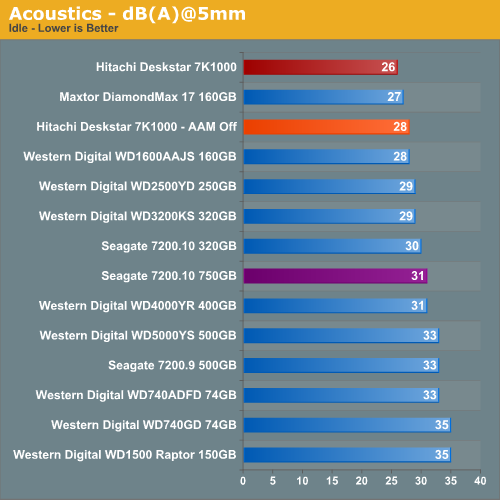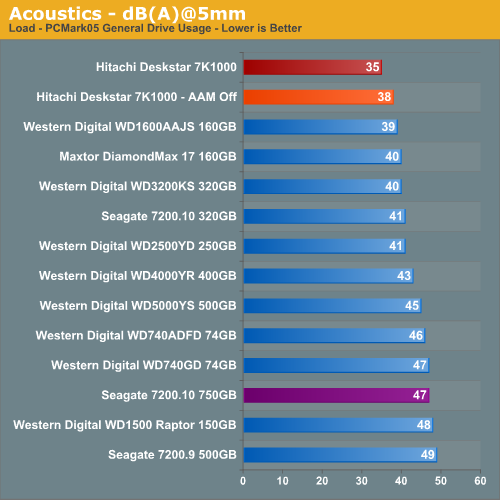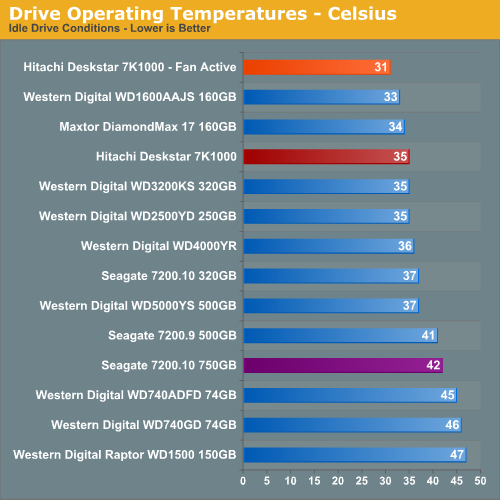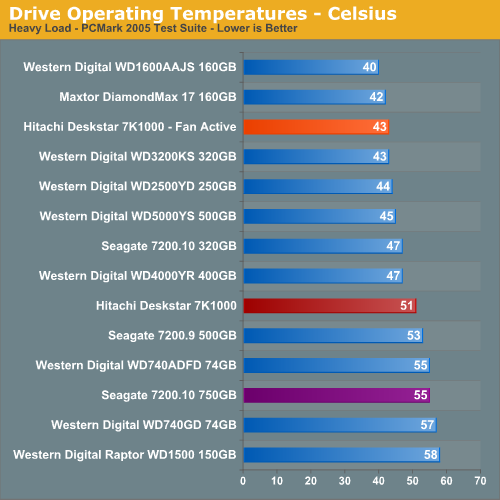Hitachi Deskstar 7K1000: Terabyte Storage arrives on the Desktop
by Gary Key on March 19, 2007 8:00 AM EST- Posted in
- Storage
Hard Drive Performance: Acoustics
Our acoustic test utilizes our standard test bed components but we implement AMD's Cool'n'Quiet technology and turn off the case fans to isolate as much case noise as possible during testing. Our OCZ power supply is nearly silent in these tests and our fanless ASUS 7600GS video card provides a further decrease in our case's ambient noise levels. Our drives are attached to the drive cage with rubber bushings to assist in isolating the noise of the drive without resulting harmonic changes due to the case design
Our acoustic tests are designed to measure the decibel levels while the system is at idle and also under load while running the General Hard Disk Drive Usage benchmark within PCMark 2005. We found through trail and error that this particular benchmark produces controlled readings across a wide range of applications within the benchmark. This particular benchmark utilizes 60% reads and 40% writes within the trace playback file.
The measurements are taken at a distance of 5 millimeters from the rear and front of the drive being tested in order to minimize surrounding environmental noise. We take our measurements over a period of twenty minutes, so idle measurements will include operating system interrupt and polling routines. We have noticed that unless we run a silent system in a near silent room that measurements taken from 1 meter are generally not meaningful due to ambient noise levels. There are exceptions like the Raptor series of drives but overall most modern desktop drives are quieter now than the other components in the system.
The reported measurements are based on an A-weighted decibel score that measures frequencies similar to the way the human ear responds to sound. We take a total of three measurements for each test. We then subtract the high and low scores and arrive at our findings by reporting the remaining score.


Our Hitachi Deskstar 7K1000 is the quietest drive that we have ever tested. We basically could not hear the drive and at times wondered if it was operating with AAM turned on. Even with AAM turned off, the drive was extremely quiet at idle and under load where it still scored better than our other test units. Our subjective opinion with AAM turned off is that the seek requests are muted greatly but still noticeable when compared to the other drives. The only other significant audible noise is a slight whirling sound as the drive spins up on a cold start or after a reboot. We just cannot emphasize enough how quiet this drive is in our test configuration with AAM enabled at the 128 setting. We even removed the rubber mounting grommets in our drive cage and did not notice any differences in acoustics or vibration levels. Our base dB(A) level in the room at time of testing was 25 dB(A).
Hard Drive Performance: Thermals
Our thermal tests utilize sensor readings via the S.M.A.R.T. (Self-Monitoring, Analysis and Reporting Technology) capability of the drives and are reported by utilizing the Active SMART 2.42 utility. We test our drives in an enclosed case environment without the front fan operational to simulate temperatures that could conceivably be reached in a SFF or HTPC case design. We typically find the reported numbers drop anywhere from 18% to 25% on average when the front fan is operational.
We typically let the drive idle for fifteen minutes before starting our idle thermal testing. Our load testing consists of taking the high temperature reading after looping the PCMark 2005 HD Suite benchmark five times. We also check load temps after looping our Nero Recode encoding test three times.


We expected the 7K1000 to run as warm as the Seagate 750GB due to the five platter design. However, under both idle and load conditions it operated significantly cooler than Seagate's large capacity PMR design. We have additional power and thermal management tests to run but at this time we were pleasantly surprised with the results. The load temperatures dropped from 51C to 43C and idle temps dropped from 35C to 31C with our front case fan operational. We highly recommend a fan be installed near the drive during normal operation. Our test room temperatures were 24C during these tests.
Our acoustic test utilizes our standard test bed components but we implement AMD's Cool'n'Quiet technology and turn off the case fans to isolate as much case noise as possible during testing. Our OCZ power supply is nearly silent in these tests and our fanless ASUS 7600GS video card provides a further decrease in our case's ambient noise levels. Our drives are attached to the drive cage with rubber bushings to assist in isolating the noise of the drive without resulting harmonic changes due to the case design
Our acoustic tests are designed to measure the decibel levels while the system is at idle and also under load while running the General Hard Disk Drive Usage benchmark within PCMark 2005. We found through trail and error that this particular benchmark produces controlled readings across a wide range of applications within the benchmark. This particular benchmark utilizes 60% reads and 40% writes within the trace playback file.
The measurements are taken at a distance of 5 millimeters from the rear and front of the drive being tested in order to minimize surrounding environmental noise. We take our measurements over a period of twenty minutes, so idle measurements will include operating system interrupt and polling routines. We have noticed that unless we run a silent system in a near silent room that measurements taken from 1 meter are generally not meaningful due to ambient noise levels. There are exceptions like the Raptor series of drives but overall most modern desktop drives are quieter now than the other components in the system.
The reported measurements are based on an A-weighted decibel score that measures frequencies similar to the way the human ear responds to sound. We take a total of three measurements for each test. We then subtract the high and low scores and arrive at our findings by reporting the remaining score.


Our Hitachi Deskstar 7K1000 is the quietest drive that we have ever tested. We basically could not hear the drive and at times wondered if it was operating with AAM turned on. Even with AAM turned off, the drive was extremely quiet at idle and under load where it still scored better than our other test units. Our subjective opinion with AAM turned off is that the seek requests are muted greatly but still noticeable when compared to the other drives. The only other significant audible noise is a slight whirling sound as the drive spins up on a cold start or after a reboot. We just cannot emphasize enough how quiet this drive is in our test configuration with AAM enabled at the 128 setting. We even removed the rubber mounting grommets in our drive cage and did not notice any differences in acoustics or vibration levels. Our base dB(A) level in the room at time of testing was 25 dB(A).
Hard Drive Performance: Thermals
Our thermal tests utilize sensor readings via the S.M.A.R.T. (Self-Monitoring, Analysis and Reporting Technology) capability of the drives and are reported by utilizing the Active SMART 2.42 utility. We test our drives in an enclosed case environment without the front fan operational to simulate temperatures that could conceivably be reached in a SFF or HTPC case design. We typically find the reported numbers drop anywhere from 18% to 25% on average when the front fan is operational.
We typically let the drive idle for fifteen minutes before starting our idle thermal testing. Our load testing consists of taking the high temperature reading after looping the PCMark 2005 HD Suite benchmark five times. We also check load temps after looping our Nero Recode encoding test three times.


We expected the 7K1000 to run as warm as the Seagate 750GB due to the five platter design. However, under both idle and load conditions it operated significantly cooler than Seagate's large capacity PMR design. We have additional power and thermal management tests to run but at this time we were pleasantly surprised with the results. The load temperatures dropped from 51C to 43C and idle temps dropped from 35C to 31C with our front case fan operational. We highly recommend a fan be installed near the drive during normal operation. Our test room temperatures were 24C during these tests.










74 Comments
View All Comments
mino - Tuesday, March 20, 2007 - link
Sorry Jared, didn't saw you comment...Otherwise, thanks for a nice review. Especially that explanation of AAM.
Many guys ask me reguraly why I don't buy non-AAM drives...
yacoub - Monday, March 19, 2007 - link
51C is a bit warm for a HD, no? I wonder how that impacts its life expectancy...yyrkoon - Tuesday, March 20, 2007 - link
To be a bit more specific, I think it was google who did testing of enterprise type drives, and did a bunch of testing, I'm sure google will turn something up ;)yyrkoon - Monday, March 19, 2007 - link
According to multiple studies done, HDD life expectancy is not affected by heat. I'm sure there are situations, where you literally have parts melting, that could be problematic, but there you have it.Justin Case - Wednesday, March 21, 2007 - link
Yes and no. A temperature around 50-60 ºC will not slowly "cook" the drive, but if it rises above a certain level (ex., 120º C), it can kill it instantly. Fast drives with a lot of platters can get hot very quickly, and if they're mounted on plastic rails (poor thermal conductors) with poor air circulation, their life expectancy is probably less than a day. I've seen it happen more than once.yyrkoon - Thursday, March 22, 2007 - link
Boiling point of water is around ~191F-212F, 120C is 248F, a CPU could not handle this temperature, what makes you think a HDD could ? Most consumer grade electronic do not take kindly to anything hottter than ~70C-80C. The only exception I can think of in a computer, might possibly be a graphics card, and even then, I personally would not expect it to last long as these temperatures.Most computers will not / should not exceed ~40C-50C ambient case temperature, and a lot (mine included) run much cooler. It is not uncommon for my CPU to run sub 100F (winter time), and sub 120F (summer time) under a load. Most of the time, the ambient case temperature of my case is easily under 105F.
Anyhow, the whole point here is: practise common sense with your electronics concerning heat. 120C is obviously WAY too hot for a HDD, as well as most consumer grade electronics. This also doesnt negate the fact that several studies have been done in enterprise envoirnments, to prove that heat ( again, within reason ) is not a factor in HDD falure. The whole point of these studies were to prove ( or disprove ) the point of buying enterprise grade hard drives vs. regular HDDs.
I have always wondered why you guys ( who ever claims that HDD fails often ) buy new HDDs with your new system, now I think I know ;)
phusg - Tuesday, March 20, 2007 - link
Please refer us to these multiple studies. AFAIK the only one that corroborates this is the google one, which you mention in a later post. Also I'd question this one study's relevance to home use, as not everyone leaves their drives running 24/7 as google does. My personal feeling is that repeated expansion and contraction damages drives most, and obviously if the drive is running hotter then the expansion will be greater and so will the damage to the longevity of the drive.yyrkoon - Thursday, March 22, 2007 - link
What you're reffering to is known as 'Hysteresus'. Excuse the bad spelling, if I misspelled that (it is not a word I used often). Anyhow, this is the effect, that rapid cooling / heating has on an object over time, and the object eventually becomming brittle because of this.As for the refferal, use google. Do not expect everyone to do your homework for you ;) However, I can tell you that, I personally have many HDDs, some of which are over 12 years old, have seen a lot of heat in their time, and are fully functional. One of which is a 80MB Maxtor . . .
Spoelie - Tuesday, March 20, 2007 - link
According to my own experience that's not really true. Last summer I had trouble with my main OS drive (a Seagate 7200.8 160GB) where windows would slow to a grind, there were multiple IO errors in the event log, then DMA would switch off and corrupt data showed up on the disc. I thought it died to be honest.However, before throwing it out I tried upping the cooling. I had 3 Seagate HDs in the HD chamber in front without intake fans, and they were incredibly warm to the touch. Directing a 120mm 800rpm fan over them to test immediately solved all issues, and the drive was as reliable again as ever (no permanent damage even). They're now very cool to the touch. Kinda obvious when I think about it, in a normal case the drive makes metal to metal contact and the HD bay itself functions as a large heat sink, while in the Antec there is no contact at all and the drive is "suspended in the air" on rubber grommets.
It was a particular hot summer period but still, heat shouldn't be ignored.
Gary Key - Monday, March 19, 2007 - link
It is well within the drives operating range and remember the temp dropped to 43C once we turned the front fan on in the case. I was expecting it to run warmer actually.